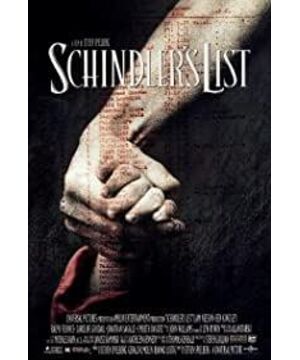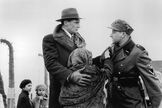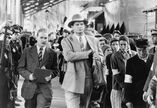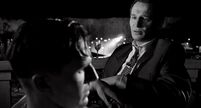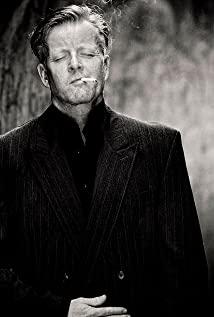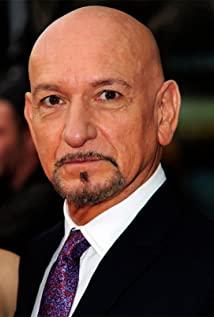As early as 1982, Sidney Schoenberg, president of MCA Universal Pictures, bought the filming rights of "Schindler's List" to Steven Spielberg, but due to his own reasons, he did not. Get ready to shoot now. Spielberg was born in a Jewish family. Although his family had a very weak Jewish culture and belief, his racial genes made him suffer from anti-Semitic harassment when he was a schoolboy, and he experienced the pain of loneliness and cold reception prematurely. Like an alien being left behind on the indifferent and desolate earth, this loneliness is deeply reflected in his film "Alien" (1982). Moreover, his elders often talked to him about the persecution of Jews. During World War II, some of his relatives were killed by the Nazis in Poland and Ukraine. Spielberg has been afraid to face this history and to be embarrassed by his Jewish identity. But he still insinuates his deep hatred of the Nazis in many of the films he directed. In the "Jones series", the Nazi forces were fictionalized, and the Nazis were exposed to the fullest, and they were eventually punished. In terms of being discriminated against by society, Jews and blacks have similar situations and feelings, and the essentially the same growth experience and tradition as blacks made him mix up the bitterness of being excluded and racial prejudice in the film " in Purple. "Empire of the Sun" is based on the concentration camp life during World War II. Although the story takes place in Shanghai, the experiences of the nations under the oppression of fascism are similar, which implies the shadow of the Jewish people who were persecuted by the German fascists and fled to Shanghai and other places to live abroad.
The "racial purification" activities carried out in Bosnia, the neo-Nazi forces in Europe and the United States, and Saddam Hussein's move to eliminate the Kurds finally made Spielberg make up his mind to film "Schindler's" in 1993. List”, perhaps as Jewish professor Alfred Palecha said: “It’s been nearly half a century since World War II, and usually 50 years is the time when people close history books.” Many surveys The data just proves that most young people today do not understand how deeply traumatized people's hearts were caused by World War II. If it is said that from the Jewish standpoint, this history cannot be forgotten, then, for human beings, it is also necessary to face it again. If we forget history, we will repeat the same mistakes. "Schindler's List" is a living history, unveiling the cruel veil of the Nazi massacre of Jews, allowing people to relive the nightmares of World War II, to experience the true meaning of "The Holocaust", and to understand the true meaning of "Holocaust" in human history. This devastating disaster, avoid a repeat of the tragedy.
As an anti-fascist film, "Schindler's List" not only condemned the war and accused the Nazis of crimes, but also profoundly revealed the historical origin of the tragedy of the Nazi massacre of Jews, and what made Hitler's prestige at the peak at that time, thus What about the revenge and madness that instigated the entire Germanic nation to purge the Jews? We know that Hitler came to power in 1932, and by 1938, Germany's GDP increased by 35% per year, which is an astronomical amount. of. Because in Germany at the time, Jews were the wealthy bourgeoisie, just as Amon Gott, the head of the concentration camp in the film, said: "600 years ago, a great plague in Europe killed countless people, Jews were accused of scourges, and the then Polish king approved When the Jews came to Krakow, they took root and developed in business, science, education, art, etc. They came with nothing and bare hands, but now they are prosperous and blossom everywhere." Inhumanely preaches racial purification, so in the film we see even German children throwing stones at the expelled Jews in hatred, shouting: "Jews, goodbye!" Jewish women in concentration camps make the gesture of smearing and beheading. It can be seen how long-standing and deep-rooted hatred is, and how war dehumanizes people and exposes the most evil side. The great thing about the film is precisely that the director Steven Spielberg did not simply classify the people in the war, but stood on the standpoint of human nature. The characters of the letter to perspective the war. There is no doubt that the film's successful portrayal of the Jewish savior Oskar Schindler and the Nazi officer Amon Gott has left a deep impression on the audience.
"Schindler's List" shows this heinous and painful history in human memory through the portrayal of the protagonist Schindler. Schindler is a complex businessman, he is a Catholic, but he is also a complete hedonist. Although he was a member of the National Socialist Party, he was also different from other Nazis. He used the means to win over the Nazi leaders, used the war to make a fortune, and hired the victims stipulated in the Nuremberg race law. It is precisely such a person who risked his life to deal with the Nazis and saved 1,100 Jews from the brink of death during the dark period of the Nazi slaughter of Jews. What motivated him to do so? No explanation is given in Thomas Keneally's original book, and Spielberg adjusted Schindler's character just right when he brought the novel to the screen, instead of making him an obvious hero, born savior , but as an ordinary person to show his charisma. The excellent and delicate performance of the Northern Irish actor Rem Neeson who played Schindler makes people feel that the change of character is the natural transformation of the victory of conscience over evil and the victory of nature over desire. The film reveals that Schindler is different from ordinary businessmen, he will repay his kindness, not only to the Nazis, but also to the Jews. Therefore, he listed all the people who helped him, such as Jewish investors, black market traders and their relatives, in the first list of hired Jews, and gave his Jewish accountants full trust and power. If Schindler started out to make money, and at the same time has a kind-hearted repayment mentality, then the opportunity that prompted him to give up the idea of returning home with a lot of money to live a luxurious life of luxury and wealth and to save the Jews without hesitation came in 1943. massacre. A year later, a year later, Schindler saw a cute little girl in red in a corpse truck, who had walked through atrocities and carnage almost unharmed to the sound of machine guns waving clubs, barking dogs, and frantically shooting. Sent to the crematorium, the ashes of burning the Jewish corpses fluttered like snowflakes on this land covered with blood and tears. In that unprecedented catastrophe, the girl was the only person he had a deep impression on. He was greatly shocked by two completely different scenes in different time and space, and Stern's words of despair about the future and his sad expression made him more determined and completely transformed. He did everything possible to rescue as many Jews as possible, showing a strong anti-war mentality. They would rather buy artillery shells and hand them over to the military than allow Jews to produce qualified artillery shells. He offered the Jews a chance to survive without compensation, respecting their national beliefs.
Amon Gott, the commander of the Nazi concentration camp, is undoubtedly an equally successful character in the film. Different from the simplistic and stereotyped images of Nazis in previous films, "Schindler's List" analyzes the cruelty and bloodshed of the war through the psychological portrayal of Gott's intrusiveness. Gott was murderous, cruel and vicious, but he couldn't help falling in love with the most unlovable Jewish girl Helen Kath. Through his eyes, you can see the thirst for love, and the unintentionally revealed tenderness is always bound by reason, and then becomes still frosty. After removing the disguise, he is actually a man who is deeply injured and lives in pain. Who can deny him. Wasn't the excuse of Schindler's guilt for kissing a Jewish girl in front of the Gestapo not a self-deception confession? His love for Helen was so desperate that he couldn't help but confided in his heart: "The problem is not with us, but with the war. They compared the Jews to a flood of beasts and parasites." The human nature numbed by the war made him vent out pervertedly. Twisted love. It is the existence of such a profound contradiction that the scene of Gott being hanged at the end is full of drama. He was arrested from a sanatorium, and killing countless people will not help the despair of the less loved soul. The stool under Gott's feet was so firm that the Red Army kicked it four times so that the legs of the stool broke and the stool fell. This scene seems so ridiculous, the solemn hatred is replaced by absurdity, but it gives the scene a rich human connotation. Whether just or unjust wars are at the expense of emotional people, the film observes the distorted human nature in the war in the ultimate sense.
"Schindler's List" has a unique artistic conception. First of all, the 193-minute film uses a documentary technique with black and white photography as the main tone, which not only highlights the historical reality, but also symbolizes the dark age of the Jewish people. Therefore, the red candlelight that runs through the film contains profound religious implications. The red figure of the little girl not only strengthens the fragility and preciousness of individual life, but is also a key factor to promote the development of the plot and promote the sublimation of Schindler's thought. When the Jews got a new life and walked out of the horizon, the color pictures that suddenly appeared on the screen brought a strong visual impact to the audience and produced a shocking emotional force. Push your emotions to a climax. Secondly, the film highlights the texture of black and white photography, which not only gives a heavy sense of history in the heavy, but also avoids the bloody violence that brings strong visual stimulation to people and conceals the deep connotation of the film, which brings a broad imagination to the audience. space, thus making the film more potentially ideological.
"Schindler's List" adopts the method of fragment combination in structure. There is no necessary logical relationship between each fragment. It does not tell a story in a dramatic way, but uses the character of Schindler as a clue to connect the entire grand history. The important events in the process are picked out to serve the perspective of human nature and the rethinking of war. The trauma that World War II brought to people's hearts is huge, and the crimes of Nazi fascism can be described as inexhaustible. Therefore, the structure of this fragmented combination reflects the connotation of the film to the greatest extent. The film is also unique in the processing of time and space. It breaks the sequence of time and space, and edits the events that happened successively in different times and different spaces in parallel. In the film, the workers were stopped to sweep the snow, and the one-armed old man Reinstein was pulled out and shot. At the same time, Schindler argued in front of the Nazi leader Julius. The real events seem to be footnotes for Schindler's defense . Another classic scene is that the film disrupts three sets of scenes in which Schindler's birthday party, Gott's unforgiving speech to Helen in the basement and then pervertedly venting his pain, as well as the Jewish wedding for a pair of young people. Similarities of emotions and similarities of sounds are reunited. Time and space are no longer important. What is important is that the film smashes history and reassembles it from the standpoint of human nature, bringing people profound reflection and permanent thinking, and exploring the eternal proposition of the relationship between war and human nature.
Like Spielberg's previous films, he is always relaxed in his grasp of the audience's emotions. He is good at incorporating humor in the sentimental atmosphere, and this humor is hidden in suspense all the time. Combining hilarious humor with menacing horror through editing, there is a desperate and unexpected effect in the suffocating tension and anxiety. For example: When Poldak emerged from the sewers to find a hiding place, he heard the whistle of Nazis and the barking of military dogs, who tactfully lied that he had been sent to clean the road. When the elder was executed, the trigger failed repeatedly. When the train carrying Jewish women is bound for the Czech Republic, it seems that the plot can no longer develop, but the film unexpectedly presents a new situation: the documents are wrong, and the train is heading for the concentration camp. After a nightmare, the Jewish women finally arrived safely at the factory. The dark humor shown in these plots gets rid of the constraints of authenticity, making the connotation of the event more qualitative, and it makes the audience think about the state of human existence in the ultimate sense. This way of pushing the situation to the limit and unexpectedly is Spielberg's usual suspense technique, and he controls the combination of suspense and humor just right.
The space of the movie picture is the space of meaning, the sharing of the picture space is the sharing of the meaning, and the opposition of the picture space is the conflict of meaning. The film is very particular about the processing of the screen space. Schindler and different characters have different processing methods in the screen, but one thing remains the same, that is, no matter how the camera angle changes, he always occupies the upper part of the screen. The upper and lower positions are always related to the strengths and weaknesses of meaning, and it highlights the strength of Schindler's personality. At the same time, the division and integration, movement and stillness of the characters in the picture are also determined according to the characters' status, emotions, and the position of the film. At the end of the film, the scene in which Schindler and Gott traded for money to buy Jews and transport them back to their hometown is meaningful. In the picture, Gott is always walking around, sometimes in the painting, sometimes out of the painting. Relatively speaking, movement is a disadvantage. Static is dominant, Schindler can always control Goth, and justice will eventually triumph over evil. In the end, the two appear in the same frame, which means they have come to an agreement.
In the use of action shots, Spielberg brilliantly combines dreamlike moving shots with fast-moving shots, giving the film a strong emotional tone.
Steven Spielberg's "Schindler's List" is not only the result of his constant artistic excellence, but "a good film made at the right time" (Time magazine in the United States), At the same time, it is also a rich treasure in the history of human civilization.
View more about Schindler's List reviews


